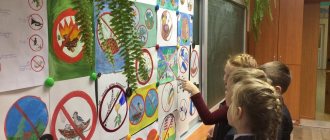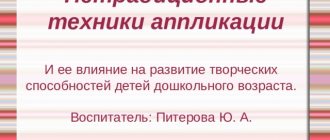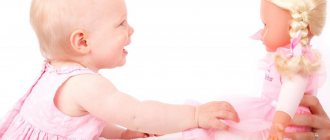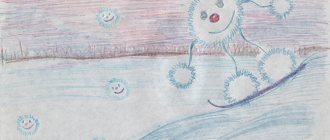The influence of productive activity on the development of a child’s personality
Author: Chernyshova Svetlana Nikolaevna
Municipal autonomous preschool educational institution
"Kindergarten No. 49 "Cheburashka" Malyshevsky urban district
Impact of Productive Activity
on the development of the child's personality
Compiled by: Chernyshova S.N.,
teacher at MADOU
"Kindergarten No. 49 "Cheburashka"
Productive children's activity is the activity of a child with the goal of obtaining a product (construction, drawing, appliqué, molded crafts, etc.) that has certain specified qualities (N.I. Ganoshenko).
Productive types of children's activities include designing, drawing, modeling, appliqué and creating various kinds of crafts and models from natural and waste materials. All these types of children's activities play an important role in the development of a child - a preschooler.
Productive children's activity is formed in preschool age and, along with play, is of greatest importance during this period for the development of the child's psyche, since the need to create a product is closely related to the development of his cognitive processes, emotional and volitional sphere, skills, moral , aesthetic and physical education of preschool children.
These actions develop not only imaginative forms of thinking, but also such qualities as focus, the ability to plan one’s activities, and achieve a certain result.
The social and personal development of a child is facilitated by the opportunity for him to demonstrate creative activity, initiative in creating drawings, modeling, and crafts that he can use himself or show and give to others.
In the process of visual activity and design, children develop the ability for purposeful activity and volitional regulation of behavior.
For the artistic and aesthetic development of a child, the modeling nature of productive activity plays an important role, allowing him to reflect the reality around him at his own discretion and create certain images. And this has a positive effect on the development of imagination, imaginative thinking, and creative activity of the child.
It is important to cultivate in children an aesthetic attitude towards the environment, the ability to see and feel beauty, and develop artistic taste and creative abilities. A preschooler is attracted to everything bright, sounding, and moving. This attraction combines both cognitive interests and an aesthetic attitude towards the object, which is manifested both in evaluative phenomena and in the activities of children.
Productive activity plays a big role in nurturing the aesthetic senses of a preschooler. The specific nature of drawing classes provides ample opportunities for experiencing beauty and for developing children’s emotional and aesthetic attitude to reality. Productive activity shows a person the world of really existing beauty, shapes his beliefs, influences behavior, and promotes the development of children’s creative abilities, which is possible only in the process of preschoolers acquiring and practically applying knowledge, skills and abilities.
Productive activity is closely related to solving problems of moral education. This connection is carried out through the content of children’s work, which reinforces a certain attitude towards the surrounding reality, and through the development in children of observation, activity, independence, the ability to listen and carry out a task, and bring the work started to completion.
In the process of depiction, the attitude towards the depicted is consolidated, since the child experiences the feelings that he experienced when perceiving this phenomenon. Therefore, the content of the work has a great influence on the formation of the child’s personality. Nature provides rich material for aesthetic and ethical experiences: bright combinations of colors, a variety of shapes, the majestic beauty of many phenomena (thunderstorm, sea surf, blizzard, etc.).
When properly organized, productive activities have a positive effect on the child’s physical development, help raise overall vitality, and create a cheerful, cheerful mood. During classes, the correct training posture is developed, since productive activity is almost always associated with a static position and a certain posture. Performing applicative images promotes the development of hand muscles and coordination of movements.
In the process of systematic classes in designing, drawing, modeling, and appliqué, cognitive processes develop:
— Children’s visual representations of surrounding objects are clarified and deepened. A child’s drawing sometimes indicates a child’s misconception about a subject, but it is not always possible to judge from the drawing whether the child’s ideas are correct. The child’s idea is broader and richer than his visual capabilities, since the development of ideas outstrips the development of visual skills.
— In the process of productive activity, the child’s visual memory is actively formed. As is known, developed memory serves as a necessary condition for successful cognition of reality, since thanks to memory processes, memorization, recognition, reproduction of cognizable objects and phenomena, and consolidation of past experience occur. Fine creativity is unthinkable without operating with images of the child’s memory and ideas obtained directly in the process of drawing. The ultimate goal for a preschooler is such knowledge of a subject that would make it possible to master the skill completely freely and depict it according to the idea.
— The development of visual-figurative thinking occurs in the learning process. Research by N.P. Sakulina showed that successful mastery of image techniques and the creation of an expressive image require not only clear ideas about individual objects, but also the establishment of connections between the appearance of an object and its purpose in a number of objects or phenomena. Therefore, before starting the image, children solve mental problems based on the concepts they have formed, and then look for ways to implement this task.
— The fundamental point in design is the analytical and synthetic activity of examining objects. It makes it possible to establish the structure of an object and its parts, and take into account the logic of their connection. Thus, a tower with a too narrow base collapses. Based on analytical-synthetic activity, the child plans the course of construction and creates a plan. The success of the implementation of a plan is largely determined by the preschooler’s ability to plan and control its progress.
— In classes on drawing, modeling, applique and design, children’s speech develops: the names of shapes, colors and their shades, spatial designations are learned, and their vocabulary is enriched. The teacher involves children in explaining tasks and the sequence of their completion. In the process of analyzing the work, at the end of the lesson, children talk about their drawings, modeling, and express judgments about the work of other children.
In the process of systematic design and application classes, children intensively develop sensory and mental abilities. The formation of ideas about objects requires the assimilation of knowledge about their properties and qualities, shape, color, size, position in space.
In the design process, preschoolers acquire special knowledge, skills and abilities. By constructing from building material, they get to know each other
— with geometric volumetric shapes;
- with techniques for modifying flat forms by bending, folding, cutting, gluing paper, resulting in a new three-dimensional form.
When designing from paper, children's knowledge of geometric plane figures, concepts of sides, angles, and center are clarified. Get ideas about the meaning of symmetry, balance, proportions;
In the process of productive activity, such important personality qualities as mental activity, curiosity, independence, initiative, which are the main components of creative activity, are formed. The child learns to be active in observation, doing work, showing independence and initiative in thinking through content, selecting materials, and using a variety of means of artistic expression.
Equally important is the education in the process of productive activity of purposefulness in work, the ability to complete it, accuracy, the ability to work in a team, diligence, and inquisitiveness.
According to teachers and psychologists, a child’s mastery of types of productive activities is an indicator of a high level of his overall development and preparation for school. Productive activities greatly contribute to the mastery of mathematics, work skills, and writing.
The processes of writing and drawing have superficial similarities: in both cases, they are graphic activities with tools that leave marks in the form of lines on paper. This requires a certain position of the body and hands, the skill of holding a pencil and pen correctly. Learning to draw creates the necessary prerequisites for successful mastery of writing.
During productive activities, children learn to use materials carefully, keep them clean and tidy, and use only the necessary materials in a certain sequence. All these points contribute to successful learning activities in all lessons.
Conclusion.
Productive activity is an important means of all-round development of children. Learning to draw, sculpt, appliqué, and design contributes to the mental, moral, aesthetic and physical education of preschool children.
Used Books:
1. Davydova G.N. Unconventional drawing techniques in kindergarten.
2. Davydova G.N. Plasticineography.
3. Doronova T.N. Materials and equipment for productive activities.
4. Dyachenko O.M. Development of a preschooler's imagination. - M.: RAO, 2000.- 197 p.
5. Mukhina BC Visual activity as a form of assimilation of social experience. - M., 2000.
6. Uruntaeva G.A.
Preschool psychology: Textbook. aid for students avg. ped. textbook establishments. 5th ed., stereotype. - M.: Publishing House, 2001. - 336 p. comments powered by HyperComments
What is children's productive activity?
The concept of “productive activity” suggests that the result of certain actions should be a certain product.
Preschool children are more process-oriented. By performing various actions, they learn about the world around them. Kids love to take a toy apart down to the last screw just to see what's inside. Creation and production of a product are not very compatible with preschool age. However, depending on what you mean by a product of children's efforts.
The productive activity of preschool children is aimed at creating a real product in the form of a drawing, craft, design, applique, crocheted square under the supervision of a grandmother and similar products.
The main feature of the productive activity of preschoolers is the emergence and materialization of a plan. If in a game the idea is realized through actions and communication, then in this case the child receives a specific product.
Productive activity has a huge impact on the development of a preschooler’s perception. When making a craft or design, the child learns object properties and relationships, understands shape and size. These characteristics become accessible to the baby’s understanding only when he puts them into practice.
Pedagogical sciences/3. Methodological foundations of the educational process
Komleva S. V.
Municipal Educational Institution of Childhood Education "Childhood Support Center", Ekaterinburg, Russia.
Productive creative activity of adolescents: methodological guidelines.
In the modern period of development of Russian society, the successful solution of political, economic and social problems increasingly depends on the action of such a subjective factor as social activity.
Teenagers have a need to convey their attitude to reality through their own journalistic activities. Young people are not indifferent consumers, but socially active thinking individuals. With the help of the media, they want to convey the opinion of their generation to others, influence the course of events, defending an active life position, without remaining indifferent observers. This is precisely the process of socialization of a teenager within the framework of the activity of publishing a newspaper.
The main goal facing a teacher of additional education is to create conditions for the inclusion of young people in creative activities with a specific practical focus. And if the productive creative activity of adolescents
- this is
the goal
, then it can be achieved by solving the following
tasks
:
· give an idea of the means of mass communication, provide professional guidance to high school students;
· teach competent communication, expression and analysis of one’s thoughts, assist in the formation of a teenager’s personal position;
· enable individuals to realize their creative potential, contribute to the preservation of social health and social adaptation;
· provide assistance in the formation of moral and aesthetic criteria, independent thinking, and civic qualities.
Principles
, which are necessary for the implementation of the assigned tasks:
· focus / striving for a common goal /;
· motivation /active, interested attitude towards joint activities/;
· structured /distribution of functions, rights, duties, responsibilities/;
· consistency /coordination of actions of participants in the activity, low level of conflict/;
· organization / planned activities, ability to manage and self-government/;
· effectiveness /ability to achieve results, availability of a real product of activity/.
Planned result
in such activities the following may be the realization of the creative and communicative potential of youth through the journalistic club “Monitor”.
This form of activity is focused on organizing intellectual, socially useful leisure time not only for gifted and talented children, but also for everyone, and is aimed at developing key competencies of the personality of adolescents, contributing to the achievement of results in personal and professional life, ensuring the teenager’s readiness for constructive interaction in social and professional relations.
Productive creative journalistic activity is relevant:
it takes into account the ever-increasing role of the media in the system of social relations, in the creation and strengthening of the ideology of the society within which they exist. In the current mass media system, teenagers, however, do not always have the opportunity to participate in the work of “adult” media. The teenage press, in this case the journalistic club “Monitor,” helps provide them with constant journalistic practice. The role of organizers, authors, and proofreaders is played by the teenagers themselves when interacting with the teacher.
The role of the teacher
additional education in the implementation of this program is more of a guide than an organizer. The teacher, in the truest sense of the word, is the same subject of activity as the student. He does not dominate children, but generously shares his cognitive potential, directing the creative energy of adolescents in the right direction, providing the necessary help in case of difficulties, developing the communication skills of students.
A special feature of additional education is the absence of strict regulations. The teacher has the freedom to choose the content, forms, means, and methods of teaching activities. On the one hand, this makes it possible to act in accordance with one’s own views and beliefs. On the other hand, the teacher’s personal responsibility for the choice made increases. In addition, the absence of strict regulations requires the teacher to take initiative.
Teacher creativity is a necessary condition for effective additional educational activities to create a newspaper.
When creating conditions for productive creative activity, special attention should be paid to methodological support.
Methods and means
additional education are methods and means of teaching, the choice of which is determined by the content and form provided for by the given program.
Among them, one can highlight methods of organizing educational and cognitive activities:
methods of obtaining new knowledge (story, explanation, conversation, working with dictionaries, organizing observation, illustration, demonstration); methods for developing skills and accumulating experience (exercises, practical activities, analysis of the product of activity).
The effectiveness of mastering any type of activity largely depends on the students’ motivation
to this type of activity. Activities proceed more effectively and produce better results if the student has strong, vibrant and deep motives that evoke a desire to act actively, overcome inevitable difficulties, persistently moving towards the intended goal.
The leading role in stimulating methods is played by the interpersonal relationship between adults and adolescents. Group of stimulation methods
can be conditionally divided into three large subgroups: methods of emotional stimulation (creating situations of success, encouragement and reprimand, the use of games and game forms, setting up a system of perspectives); methods for developing cognitive interest (forming a readiness to perceive educational material, building a field of practical application around the material, a method of stimulating with entertaining content, creating a situation of creative search); methods of forming responsibility and commitment (the perspective of the final result - the product of activity, non-interference of the teacher in the process of organizing and performing role-playing activities).
Introduction of methods for organizing interaction
teenagers and the accumulation of social experience contributes, firstly, to the accumulation of social communication experience among students and, secondly, to the development by teenagers of social methods of organizing developmental and educational activities.
The formative element in these methods is dialogical communication
students.
Dialogue forms and supports joint educational activities in the classroom, in which the development of participants in a common cause occurs. methods for organizing the interaction of participants
can be distinguished mastering the basic norms of conversation; peer verification methods; method of joint tasks, jointly finding the best solution; temporary work in groups; creating situations of shared experiences; discussion.
Additional education effectively develops a number of features not provided for in the traditional curriculum. We are talking about the ability for reflection, imagination, the ability to take risks without fear of a possible mistake, the ability to independently develop a program of one’s actions and implement it, and the ability to be creative.
Psychological methods for the development of mental functions and creative abilities
teenagers dominate in the organization of this form of work. The greatest effect is achieved by methods such as: creative task; posing a problem or creating a problematic situation; creation of a creative field; transition from playful to real-practical activities; analysis of the product of activity.
Newspaper release –
one of the popular forms of organizing additional education. This has long been a widely known form of organizing students’ extracurricular activities.
In the process of becoming familiar with working with the printed word, there are many advantages: journalism develops attention and observation, composure and criticality, the ability to master the word and navigate the increased flow of information. Working on publishing a newspaper helps teenagers express themselves and, to some extent, is career guidance. A modern person must have excellent knowledge of information technology. Web design expands the possibilities in the design of material and creates a certain culture of working with text. A newspaper published by printing increases the status of both the press itself and the prestige of working in the youth editorial office.
The main thing around which educational activities are built is the publication of a real newspaper with a specific circulation.
A youth newspaper as an information center allows you to influence high school students and students through the content of published materials, helps to improve information culture, familiarize yourself with modern printing technologies, and master practical skills.
Productive activities for preschoolers
Not every child’s activity leads to a visual product. And the game can please you with the results. For example, in a role-playing game, a child can learn to set the table or understand how shopping occurs in a store. During the game, communication skills develop, children find their friends. These are all important results. But not substantive, not material.
Productive species include:
- Visual activities
- Construction
- Needlework
It is possible that some parents are hesitant to call the result that their child gets after experimenting with paints or connecting some parts of a construction set a product. From the point of view of qualitative characteristics, the result performed by a preschooler is often rather weak... Moreover, adults need to remember that the child demonstrates everything he does with the desire to hear support and praise, and not criticism.
Productivity of fine arts and crafts
Fine arts include drawing, modeling and decorative arts. This could be making appliques and other crafts. Handicraft is also close to this type, although it requires more technical skills, and therefore is available already at older preschool age.
As soon as a child of three or four years old sees a certain object in his scribbles, we can assume that he has created his first product. This means that the child did not just randomly draw on the sheet. He had a plan! And what happened is age appropriate.
In middle preschool age, children draw quite recognizable images. Figures from plasticine are not yet made, but simple forms are already quite realizable. Every child can make an apple, a cucumber, a plate.
Children 6-7 years old have fully developed drawing and modeling skills. Assiduous, attentive children are interested in creating appliqués and are interested in knitting and sewing. If someone in the family is interested in needlework, older preschoolers will definitely get involved in this activity.
Product of activity in design
When classifying design as a productive activity, it is important to keep in mind that the product in this case is temporary. It is rare that a structure can be preserved for a long time. Perhaps an older preschooler will make a car, a crane, or a robot according to a diagram from metal or plastic parts, and he will want to keep the successful model for a certain time.
Any design has a short life. Children build, assemble an object, look at it, encourage others to look, expect to hear praise and... soon destroy it in order to create something else.
But it is obvious that this activity is carried out by the child for the sake of a specific product. This is exactly the type of activity that gives the preschooler the opportunity to see visual achievements.



